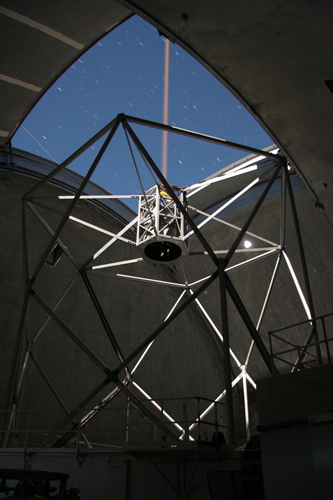Kamuela, HI— The W. M. Keck Observatory has received a $1.72 million grant from the National Science Foundation (NSF) to design the first near-infrared tip-tilt sensor used to correct for the turbulence in Earth’s atmosphere. The improvements will increase the sensitivity and resolution of the Keck I telescope, which already allows astronomers to resolve in the near-infrared as much detail or more as the Hubble Space Telescope resolves in visible light.
The grant from NSF’s Advanced Technologies and Instrumentation (ATI) program provides the Observatory with the funding to design, construct and implement a near-infrared tip-tilt sensor with the Keck I Laser Guide Star (LGS) Adaptive Optics (AO) system and OSIRIS, a near-infrared integral field spectrograph and imager. An adaptive optics system removes the blurring effect of the Earth’s atmosphere, taking the twinkle out of stars. The new instrumentation will be developed in collaboration with Caltech Optical Observatories, which will be building the camera to be used in the sensor.
“Every innovative, significant adaptive optics improvement has triggered new discoveries, from the structure of the rings of Uranus, to direct imaging of extrasolar planets, to the size and nature of the environment around the Galaxy’s central black hole, to the morphology of high-redshift galaxies,” said Keck Observatory Director Taft Armandroff. “The Observatory’s new near-infrared sensor is a major advancement in adaptive optics and will contribute significantly to future discoveries.”
The current Keck LGS AO facilities use a wavefront sensor looking at a laser-based artificial star to measure the turbulence in the atmosphere and a deformable mirror to correct for this turbulence about 1000 times every second. The artificial star has no information about the image motion introduced by the atmosphere so currently a visible tip-tilt sensor is used to control a fast tip-tilt mirror in the AO system. The resulting images are sharp, allowing astronomers to observe minute details of cosmic objects, such as storms on Uranus or the shape of extremely distant galaxies.
The new infrared tip-tilt sensor will improve the AO performance by doing the tip-tilt sensing at near-infrared wavelengths where the stars images are smaller due to the corrections provided by the AO system, and where the stars are brighter. This will increase the amount of sky and number of cosmic objects astronomers can study with the Keck I LGS AO system. It will also provide even more resolution for astronomers to better study the birth of supermassive stars, the internal properties of early, star-forming galaxies and the existence of galaxies that have no stars and emit no light called dark matter galaxies.
In 1999, the Observatory implemented the first AO system on an 8-10 meter class telescope, the Keck II telescope, and then followed with a similar facility on Keck I in 2001. The Keck II facility was upgraded to a LGS AO facility in 2002 and a faster control system was incorporated in 2007.
The near infrared tip-tilt sensor upgrade is intended to maintain the Observatory’s global leadership in AO, and astronomy. With the funding, the team will continue to improve the Observatory’s AO system benefitting a significant number of astronomers, said Thomas Stalcup, the project manager for this NSF award.
Through NASA and the NSF/NOAO Telescope System Instrumentation Program, the entire U.S. community has access to the Observatory’s AO-corrected 10-meter telescopes. The Observatory provides a third of the overall U.S. community’s observing time on large telescopes, as well as to University of California, Caltech and University of Hawai’i astronomers.
The technology of adaptive optics “is amazing and the scientific applications fascinating. I study topics like galaxy formation, black holes, and gravitational lensing, all of which require the study of extremely faint and small targets,” said Tommaso Treu, an astronomer at the University of California, Santa Barbara and the principal scientist for the Observatory’s tip-tilt sensor. “For this reason, I am very interested in upgrades that can push the envelope of what is feasible with AO. The new tip-tilt sensor will be a major advance for my area of science, as well as many others.”
Peter Wizinowich, the principal investigator for this NSF award and the Observatory’s AO lead, added that the new sensor will not only directly produce significant science returns on an existing LGS AO facility. It will also provide an on-sky science demonstration of this key technology, identified as a top priority of the 2008 U.S. AO Roadmap for next generation AO systems on existing and extremely large telescopes.
Along with the tip-tilt sensor, Wizinowich and the AO team will improve the Keck II telescope’s LGS AO facility through a $1.3 million grant from NSF’s Major Research Instrumentation Program awarded in 2009. According Jason Chin, the award’s project manager, the funding will allow Keck AO scientists to design a laser launch telescope that will be positioned behind the telescope’s secondary mirror.
The laser is currently launched from the side of the Keck II telescope. The “center-launch” of the laser will provide even sharper science images with the existing Keck II LGS AO system, resulting in more precise brightness and position measurements of cosmic objects.
Both the new center-launch of the laser and the infrared tip-tilt sensor are steps towards the development of the Observatory’s Next Generation Adaptive Optics, or NGAO, system. NGAO is an innovative AO facility that will monitor and correct for atmospheric turbulence with multiple laser guide stars, advanced wavefront monitoring and extremely sensitive instrumentation. As the upgrades in Keck’s AO system evolve into NGAO, the Observatory’s telescopes will provide near infrared resolution equal to or better than that of the James Webb Space Telescope, currently the most sophisticated space-based observatory under construction.
The W. M. Keck Observatory operates two 10-meter optical/infrared telescopes on the summit of Mauna Kea on the island of Hawai’i and is a scientific partnership of the California Institute of Technology, the University of California and NASA. For more information please call 808.881.3827 or visit http://www.keckobservatory.org.


